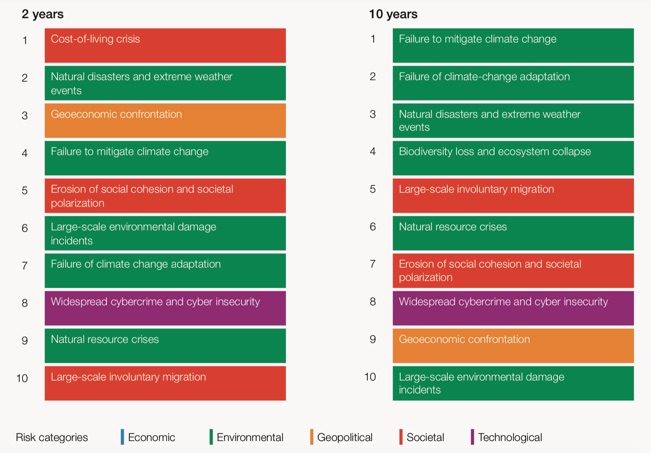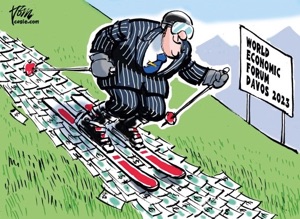News
18 January 2023
Everybody is worried about increasing inequalities … except the super-rich and our leaders, of course!
-
The iconic World Economic Forum (WEF), created in 1971, that regroups the powerful and rich of this world (a few thousand people) met on 16 January for the 53rd time in the small luxury resort of Davos. This posh club, funded by an annual fee ranging from several tens of thousands of dollars to hundreds of thousands of dollars charged to large participating companies, is certainly the symbol of the alliance between the business world and governments.
-
-
Let’s recall here that the WEF was the co-organizer of the Food Systems Summit jointly with the UN, New York, in September 2021 [read].
-
-
In The Global Risks Report 2023 that provides the context of this meeting, WEF presents the results of the Global Risks Perception Survey of 1,200 experts from academia, businesses, governments, international organizations and civil society carried out in September/October 2022.
The tone of the results contrasts with the usual content of documents produced by the WEF that generally project the positive image of a world where private sector-led science, technological progress and economic growth propel humanity in an ever-improving world (improving the state of the world is, by the way, the main declared objective of WEF [read]).
Indeed, the executive summary of the report emphasizes the breadth of the risks threatening the world, making a distinction between:
-
•“older” risks, such as inflation, trade war, capital outflows from emerging markets to richer countries with stabler currencies, social unrest, geopolitical conflicts that could lead to the use of nuclear weapons, and
-
•“new” risks, such as an increasingly unsustainable debt, slow growth and reduced investment, “de-globalization” (it is worth remembering here that WEF has been one of the main promoters of globalization), decline in human development, the development of dual-use technologies (both civilian and military), and of course, climate change.
The WEF report ranks them by order of importance as perceived for the short and long term (Fig.1). It is interesting to note that in the short as well as in the long term, there are no economic risks among the 10 most important, and the environmental risks are the most frequent.
Fig. 1: Global risks ranked by severity

Source: WEF
One may be surprised by this classification (are debt and dual-use technologies really new risks?) and by the virtual absence of inequalities that are hardly mentioned and that, according to this report, would exist mainly across countries and would be a source of concern only in the digital sector. Moreover, when dealt with, they are only discussed indirectly using the concepts of “social cohesion and polarization”.
This quasi absence contrasts with the severity described and the importance given to inequality in a recent report on poverty published by the French Observatory of inequalities (Observatoire des inégalités)1 and, at international level, in the recently issued report by Oxfam [read] that shows in particular that the public money injected in the global economy since the beginning of the COVID-19 pandemic was mostly captured by the 1% richest people (more than 60% of the total) and that billionaires have seen their wealth (in real terms, adjusted for inflation) multiplied by 20 in 35 years and increased by 55% in 2021 only (Fig.2). Let’s also remind here that FAO, in its report on the Future of Food and Agriculture of 2022, identified the reduction of inequalities as one of the main conditions of the advent of a desirable future [read].
Fig. 2: Increase in billionaire wealth in US$ trillion (real terms) over the 1987–2022 period

Source: Oxfam based on Forbes World’s billionnaires list.
The WEF report proposes a description of the future (something that is always quite risky) and depicts a rather gloomy picture of this coming decade, mainly because of the risks arising from the failure to combat climate change and protect ecosystems. This described future is one of stagnation, inflation and geopolitical tensions, of fragmentation of value chains essential for the whole economic system, as well as of a “rockier” restructuring and debt distress.
According to WEF, these processes will result in the further worsening of poverty, hunger, social protest, political tension and inequality within and across countries, and bring about a rollback in human development. The report does, however, not propose any explanatory theory of the whole set of ongoing processes and of the root causes of this alarming trend. As a result, it is not in a position to make clear and credible recommendations. One of the reasons for this limitation is because it addresses each question in isolation and does not adopt a holistic systemic approach.
By restricting its scope to taking stock of the worrying situation and perspectives, it carefully avoids to identify the underlying causes, particularly the paradigms of which WEF itself has been the promoter, that shape the mainstream worldview underpinning most of the policies implemented at national, regional and international level.
Its recommendations, of a rather general nature, appear to be there to preserve the internal logic of past and current human action (i.e. the pursuit of growth and profit, short-termism) and they do not represent in any manner a way to resolve the multiplicity of intertwined systemic crises with which humanity has to cope (and of which its activities are the main cause) so as to propel the world on the path of a desirable future.
---------------------
Note
-
1.The report of the French Observatory of inequalities stresses that in 2020, there were around 4.8 million people living below the poverty threshold in France (8% of total population and 500,000 more people than in the year 2000), of which 2 million living in extreme poverty [read in French].
————————————-
To know more :
-
•Oxfam, Survival of the Richest - How we must tax the super-rich now to fight inequality, 2023.
-
•WEF, The Global Risks Report 2023 18th Edition, World Economic Forum, 2022 (en anglais).
-
•FAO, The future of food and agriculture – Drivers and triggers for transformation, The Future of Food and Agriculture, no. 3, FAO Rome, 2022.
-
•Observatoire des inégalités, Rapport sur la pauvreté en France, édition 2022-2023, 2022 (in French).
-
•Chancel, L., Piketty, T., Saez, E., Zucman, G. et al. World Inequality Report 2022, World Inequality Lab, 2021.
Selection of past articles on hungerexplained.org related to the topic:
-
•Opinions: A strange Summit by George-André Simon 2021.
-
•Growing inequalities are a threat to world social and political stability, 2017.
-
•The World Economic Forum’s “New Vision for Agriculture” is moving ahead on the ground…, 2017.
-
•Opinions: How to stop the global inequality machine by J. Hickel, 2017.
Last update: January 2023
For your comments and reactions: hungerexpl@gmail.com



